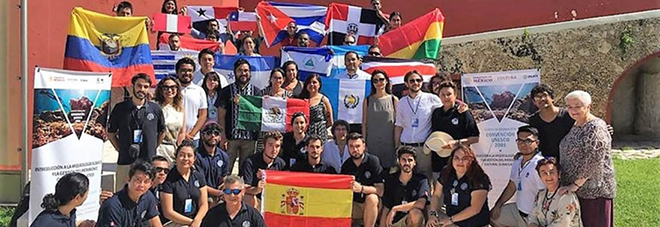Welcome to
UNESCO UNITWIN Underwater Archaeology Network
Covid-19 and the UNITWIN Underwater Archaeology Network
As for any network, the Covid-19 pandemic has radically altered our opportunities for interaction. In recognition of the fact that now, more than ever, the chance to meet and discuss the things we share a passion for is critical, we are holding the next meeting virtually on Thursday 23rd April at 12:00 UCT. If you have not received an invitation but would like to join the meeting, please email R.H.Farr@soton.ac.uk.
We look forward to seeing everyone and to trialing an approach that will help the Network to reach more people, more easily, and reduce our carbon footprint.
Best wishes to all our colleagues
Helen, Fraser and Lucy
PILAR LUNA ERREGUERENA (1944-2020)
The loss of Pilar leaves a huge void in our international community. She was the first archaeologist who began to study and preserve the underwater cultural heritage of her country, Mexico, fully aware of the potential it had both in maritime and inland waters. This was a particularly challenging endeavor in the early times, when she had to face all sorts of obstacles and on many fronts.
Her professional accomplishments cannot be summarized in these few words, but they are manifested in a great number of research and management projects that in turn resulted in various publications -both academic and for the general public-, mass media products, museum displays, and legislation documents. Among the latter, she played a prominent role in the development of the UNESCO 2001 Convention. As part of the Mexican delegation for many years, and being one of the first members of the Scientific and Technical Advisory Body to the Convention, she made many contributions to the Convention itself and related outcomes. During the long and difficult discussions around the Convention, Pilar always had wise and respectful interventions, creating bridges and trying to find common ground.
In the context of UNITWIN, I want to stress Pilar´s continuous work in capacity building, not just for Mexicans but for people from all over Latin America. Many students and graduates in this part of the world, like myself, got involved in underwater archaeology in one way or another thanks to Pilar. She always managed to provide training opportunities: For instance, she would bring experts to teach in Mexico and extend the invitation to as many other countries in the region as possible, or she would send members of her team to share their knowledge in other projects which were in early stages of development, as was the case with our work on the HMS Swift back in 1998. She would also seek support from UNESCO and other stakeholders to make training in maritime archaeology widely accessible and with high standards.

Pilar (standing in the right of the photograph) during the UNESCO training course held in Campeche, Mexico, in 2019. The course had participants from 12 Latin American countries.
© UNESCO-INAH, México. Julio, 2019. Courtesy Helena Barba-Meinecke.
Pilar was not only a pioneer and a renowned maritime archaeologist but also a wonderful human being, the kind of person who makes the world a better place.
Dr. Dolores Elkin (Argentina)
Researcher at CONICET (National Research Council)
Director, Underwater Archaeology Programme, National Institute of Anthropology
Professor, Seminar on Research and Management in Maritime Archaeology, University of Buenos Aires
Member of the Scientific and Technical Advisory Body to the UNESCO 2001 Convention
Prof. Sebastiano Tusa

The UNESCO UNITWIN Network is profoundly saddened to hear the news of the Ethiopian Airliner crash that included our friend and colleague Prof Sebastiano Tusa.
He played a significant role in the development of underwater archaeology globally and was a true advocate for the protection of underwater cultural heritage. He was passionate, full of energy, and leaves an outstanding track record. His legacy will live on in our field, among friends, colleagues, and students, and the many whose lives he touched. Plenus annis abiit, plenus honoribus—He is gone from us, full of years and full of honors.
Our deepest condolences go to Professor Tusa's family, and to his many colleagues and friends.
Michel L’Hour (France) wrote:
Sebastiano Tusa had for almost a year started a political life as an elected member of the Sicilian Region "assessore per i Beni culturali della Sicilia" (adviser on cultural heritage of the Sicilian government), but he was above all the founder in 1999 of GIASS (Gruppo Intervento Archeologia Subacquea Sicilia) which in 2004 became the Soprintendenza del mare of Sicily , which he ran until last year. A prehistorian by training, a subject he taught at Sister Ursula Benincasa University, he has dedicated most of his life to maritime archaeology, always with an extraordinary dynamism and energy. Since the 1990s he has been one of the leading figures in underwater archaeology in Sicily above all but also in Italy and internationally. We will limit ourselves to recalling his recent research, which has made it possible to locate with confidence, thanks to the discovery of numerous bronze spurs, about a hundred deep, the site of the naval battle of the Egadi Islands, in Sicily, which ended the first Punic War between Rome and Carthage on 10 March 241 BC.
A strange correspondence of fate wanted Sebastiano has meant that Sebastiano died the same day, March 10, 2019.
It leaves unquestionably a big void in the Italian and international underwater archeology.
Tusa was going to the Regional Conference on the Protection of Underwater Cultural Heritage and Sustainable Tourism Development in Eastern Africa, held on 11 March in Malindi, Kenya, where he was to deliver the opening speech.
Marnix Pieters (Belgium) wrote:
Although I don’t know Sebastiano Tusa personally, I’m familiar with his groundbreaking work related to the site of the ‘Naval battle near the Egadi Islands, 241 BC, naval battle between Rome and Carthago’. For me this is cutting-edge research on difficult underwater sites such as naval battles of an ancient past.
|
 |
|




